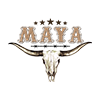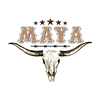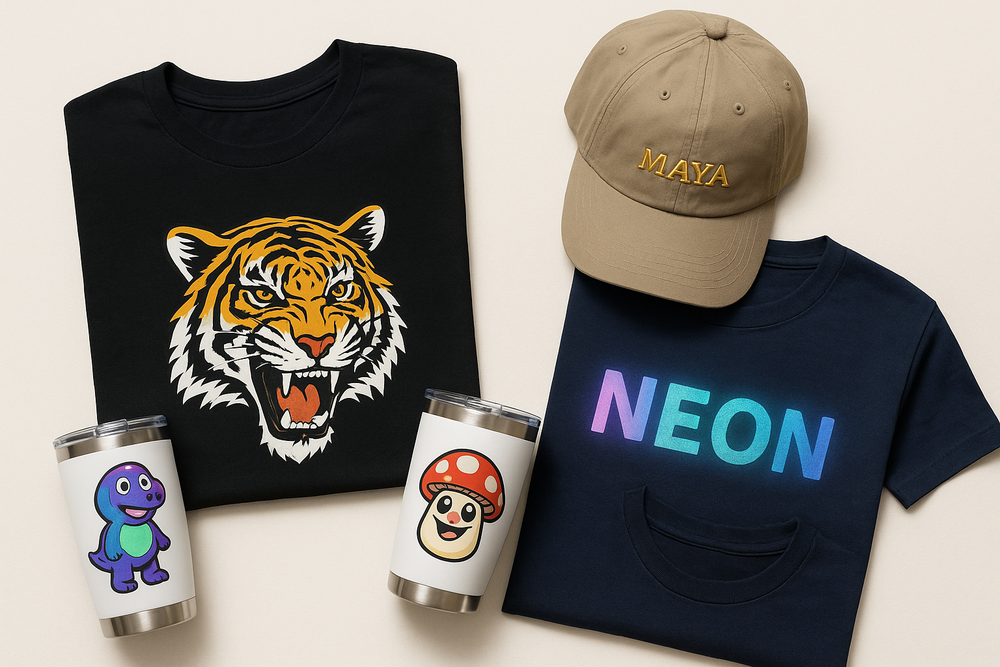How DTF Transfers & UV DTF Unlock Scalable Print‑On‑Demand for Custom Apparel: Blank T‑Shirts, Hoodies, Hats & Dropshipping
How DTF Transfers & UV DTF Unlock Scalable Print‑On‑Demand for Custom Apparel: Blank T‑Shirts, Hoodies, Hats & Dropshipping
DTF transfers and UV DTF are reshaping how entrepreneurs, small apparel brands, and Etsy/Shopify sellers scale print‑on‑demand (POD). Whether you sell custom t‑shirts, hoodies, hats or want to combine prints with embroidery accents, these technologies reduce setup costs, broaden substrate compatibility, and enable agile dropshipping. This in‑depth guide explains the tech, compares processes, offers production and marketing tactics, and shows how MAYA TX helps with same‑day pickup in Austin, nationwide shipping, dropshipping fulfillment, and a wide selection of blank apparel.
Quick overview: What are DTF transfers and UV DTF?
DTF transfers (Direct‑to‑Film) use pigment inks printed on a special PET film, a hot‑melt adhesive powder applied, and then the ink/powder is cured. The finished film transfer is heat‑pressed onto garments. UV DTF refers to variations that use UV‑curable inks and UV lamps for faster curing and potentially improved surface durability. Both approaches create standalone transfers you can store, ship, or apply per order—perfect for POD and dropshipping models.
Why DTF transfers are powerful for custom apparel and POD
- No minimum runs: Produce one piece at a time with the same color fidelity as larger runs.
- Fabric flexibility: Works well across cotton, polyester blends, and many synthetics where DTG struggles.
- Color and detail: Excellent for multi‑color designs and photographic prints without the cost of spot screens.
- Inventory efficiency: Store transfers instead of finished garments to reduce warehousing costs.
- Easy shipping: Transfer films are flat and lightweight, better for fulfillment logistics.
What makes UV DTF different and when to use it
UV DTF employs UV‑curable inks and immediate curing via UV lamps, which speeds throughput and can improve surface hardness. Use UV DTF when you need:
- Faster production cycles with instant ink cure
- Reduced thermal stress on delicate garments or heat‑sensitive substrates
- Potentially higher surface abrasion resistance for certain applications
Test carefully: UV formulations and film chemistries vary between vendors. Always perform wash and abrasion tests before scaling.
DTF vs DTG vs Screen Printing vs HTV: an actionable comparison
Choosing the right printing method depends on volume, fabric mix, design complexity, hand feel expectations, and margin goals.
- DTF transfers: Best for POD, multi‑color art, dark garments, and mixed fabric blends. Low setup, high versatility.
- DTG (Direct‑to‑Garment): Excellent for soft hand feel and high detail on 100% cotton. Requires pretreatment, less effective on polyester blends.
- Screen printing: Lowest per‑unit cost at high volumes, great for spot colors and specialty inks. Not ideal for one‑offs or highly complex full‑color images without expensive separations.
- HTV (Heat Transfer Vinyl): Durable and clean for simple logos and shapes. Inefficient for photorealistic or highly detailed multi‑color artwork.
Recommendation: If you run a POD shop with frequent one‑offs or small runs across varied fabrics (blank t‑shirts, hoodies, hats), DTF or UV DTF often gives the best balance of speed, cost, and visual impact.
Use cases by garment type: t‑shirts, hoodies, hats and hybrids
Practical advice for each product category:
- Blank t‑shirts: The largest market for POD. DTF works on cotton and blends—hand feel varies by transfer thickness. Offer multiple blank options (ringspun, tri‑blend, organic) to appeal to different buyers.
- Hoodies: Thicker fabrics require adjusted press time and pressure. Puff, soft‑hand, or heavy‑duty transfers may be used. Consider inside neck label printing combined with DTF front prints for a premium feel.
- Hats: Due to curved surfaces, apply flat patch transfers or use pre‑formed patches. Another strong option: combine embroidered logos with small DTF details for standout texture.
- Embroidery hybrids: Combine DTF prints with embroidery to offer premium products—DTF for full‑color designs, embroidery for textural brand marks.
Detailed production workflow: file to shipped order
Scale reliably with a documented, repeatable workflow. Here's a production checklist you can implement:
- Design & prepress: Use vectors for logos, PNG/PSD/TIFF at 300 dpi for raster art. Keep sRGB/RGB originals and rely on supplier ICC profiles for color conversion.
- Soft proof & mockups: Create realistic mockups for listings and confirm color with physical proofs for critical SKUs.
- Print to film: Use a calibrated printer and RIP software for consistent color output; print test patches.
- Adhesive application: Apply hot‑melt adhesive powder evenly; shake off excess and cure properly per supplier instructions.
- Transfer press: Optimize temperature, pressure, and time. For DTF, typical ranges might be 320–360°F for 10–18 seconds but always follow film manufacturer guidelines and test with your blank apparel.
- Post‑press QC: Check adhesion, hand feel, and print accuracy; perform a wash test or accelerated wash cycle for new setups.
- Packing & labeling: Use branded inserts, size labels, and protective packaging to reduce returns and increase perceived value.
- Fulfillment: Ship directly to customers using a POD/dropship partner or handle locally for same‑day pickup orders.
Quality control and testing: don't skip this
To reduce complaints and returns, create a QC process:
- Run a 3‑wash durability test on new transfer/blank combinations.
- Maintain a color consistency log with delta E measurements if available.
- Inspect 100% of first production pieces after changing inks, films, or blanks.
- Track return reasons to spot recurring issues (adhesion, cracking, color shift).
Integrating dropshipping and fulfillment: automation tips
To scale, automate order routing, fulfillment, and tracking updates. Consider these steps:
- Choose a fulfillment partner that supports API or platform integrations (Shopify, Etsy, WooCommerce).
- Map SKUs between your storefront and the fulfillment provider to eliminate manual order entry.
- Automate shipping confirmations and tracking emails to reduce support tickets.
- Offer branded packing slips or inserts through your dropship provider to reinforce brand identity.
MAYA TX offers dropshipping fulfillment where we print and ship for your customers. Learn more at MAYA TX DTF Transfers, MAYA TX UV DTF, and browse blanks at MAYA TX Blank Apparel.
Pricing strategy and margin examples
Build pricing based on landed cost + profit margin. Example formula:
Landed cost = base blank price + DTF transfer cost + packaging + average shipping + platform fees + returns reserve.
Target margins: 40–60% for mid‑range products, 60%+ for premium or niche goods with higher perceived value.
Example quick math:
- Blank tee: $6.00
- DTF transfer & application: $5.00
- Packaging & shipping (avg): $4.00
- Platform & payment fees: $2.00
- Total landed cost: $17.00 — sell at $34.99 to hit ~51% margin.
Marketing, SEO, and product page optimization
Drive traffic and conversions with optimized product pages and listings:
- Title and H1 include target keywords: "DTF transfers," "custom apparel," "blank t‑shirts," "hoodies," "hats," "print‑on‑demand," and "dropshipping."
- Meta descriptions: keep them between 140–160 characters and compelling for clicks.
- Use high‑quality lifestyle photos and mockups; show close‑ups of print hand feel and labels.
- Include bullet lists of material, care instructions, and production lead times to reduce returns.
- Publish blog content and resource pages that answer buyer questions: "What is DTF?" "How long do DTF prints last?" linking internally to product pages.
For platform integration and marketing advice, check resources like Printful, the Shopify Blog, and Oberlo Blog for growth tactics and case studies.
Trending designs, niches and side‑hustle ideas for 2025
Designs that convert in 2025:
- Micro‑niche communities with strong identity signals (hobbyist groups, subcultures).
- Personalized and monogrammed gifts—pair DTF with small embroidery patches to justify higher prices.
- Local and hyperlocal designs (neighborhood maps, city landmarks) that perform well with same‑day pickup or local ads.
- Eco‑conscious collections marketed with organic blanks and transparent supply chains.
Side‑hustle idea: Launch a limited release capsule each month (10–20 designs) to create urgency and test ad campaigns with small budgets.
Common pitfalls and how to avoid them
- Poor color matches: Always order physical proofs before running large campaigns.
- Ignoring hand feel: For apparel, perception often matters more than image sharpness—test different film weights.
- Underpricing: Account for returns, ad costs and platform fees in your margins.
- Skipping QA: A single bad batch can generate negative reviews—implement a QC checklist.
Checklist before launch
- Order sample packs of blanks and printed samples from your provider.
- Run wash and rub tests for each transfer/blank combo.
- Create SEO‑optimized listings and product pages with clear lead times.
- Set up fulfillment automation and test an end‑to‑end order.
- Plan a small paid ad test and measure CAC (customer acquisition cost).
Conclusion: Should you adopt DTF or UV DTF for your POD business?
For entrepreneurs and small brands focused on scalability, variety, and low‑risk testing, DTF transfers and UV DTF are compelling options. They let you sell diverse products—blank t‑shirts, hoodies, hats—without large inventory commitments, and they integrate well with dropshipping fulfillment models. Pairing DTF with strategic branding, QC, and fulfillment automation unlocks sustainable margins and growth.
Call to action
Ready to scale your custom apparel business with DTF or UV DTF? MAYA TX supports same‑day pickup in Austin, nationwide shipping, and dropshipping fulfillment—we print and ship for your customers and carry a wide selection of blank apparel. Get started:
- Order DTF Transfers
- Explore UV DTF
- Shop Blank Apparel
- Contact MAYA TX to set up dropshipping fulfillment and ask about same‑day pickup in Austin
If you want a tailored recommendation for your Shopify or Etsy store, reach out to MAYA TX and we’ll help you choose the right blanks, transfer types, pricing strategy, and fulfillment workflow to maximize margins and customer satisfaction.


